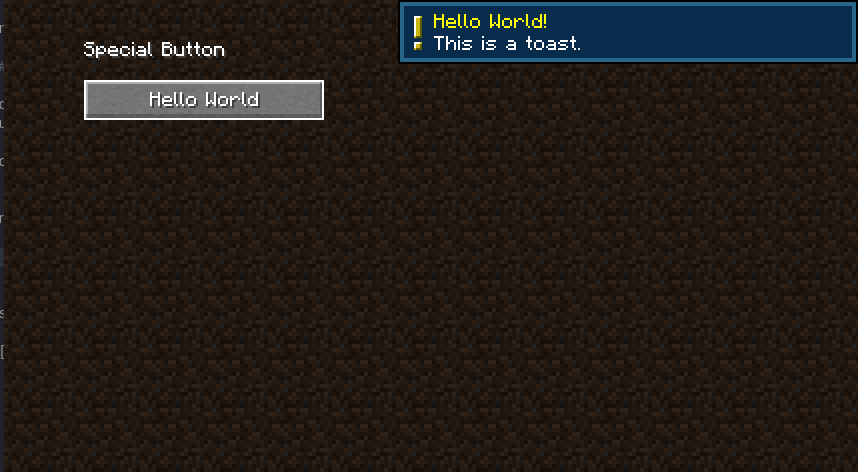INFO
本文所述均指一般的、未涉及同步的界面,这类界面是由玩家独自在客户端打开的,不需要服务端的参与。
界面是指玩家可以交互的 GUI,比如标题界面、暂停界面等。
您可以创建自己的界面来展示自定义内容、自定义配置目录等。
创建界面
要创建界面,您需要继承 Screen 类并覆写 init 方法。您可能还需要覆写 render 方法,但是请保证调用 super.render, 否则背景和组件都不会渲染。
您需要注意:
- 组件不应该在
Screen的构造方法里创建,因为此时界面还没有初始化,并且某些变量(比如界面的宽width和高height)也还没有正确地初始化。 - 当界面正在初始化时,
init方法将被调用,这是创建组件对象的最佳时机。- 您可以通过
addDrawableChild方法来添加组件,这个方法接收任何实现了Drawable和Element接口的组件对象。
- 您可以通过
render方法将在每一帧被调用,您可以在这个方法里获取诸多上下文,比如鼠标的位置。
举个例子,我们可以创建一个简单的界面,这个界面有一个按钮和一个按钮的标签。
java
public class CustomScreen extends Screen {
public CustomScreen(Component title) {
super(title);
}
@Override
protected void init() {
Button buttonWidget = Button.builder(Component.nullToEmpty("Hello World"), (btn) -> {
// When the button is clicked, we can display a toast to the screen.
this.minecraft.getToastManager().addToast(
SystemToast.multiline(this.minecraft, SystemToast.SystemToastId.NARRATOR_TOGGLE, Component.nullToEmpty("Hello World!"), Component.nullToEmpty("This is a toast."))
);
}).bounds(40, 40, 120, 20).build();
// x, y, width, height
// It's recommended to use the fixed height of 20 to prevent rendering issues with the button
// textures.
// Register the button widget.
this.addRenderableWidget(buttonWidget);
}
@Override
public void render(GuiGraphics context, int mouseX, int mouseY, float delta) {
super.render(context, mouseX, mouseY, delta);
// Minecraft doesn't have a "label" widget, so we'll have to draw our own text.
// We'll subtract the font height from the Y position to make the text appear above the button.
// Subtracting an extra 10 pixels will give the text some padding.
// textRenderer, text, x, y, color, hasShadow
context.drawString(this.font, "Special Button", 40, 40 - this.font.lineHeight - 10, 0xFFFFFFFF, true);
}
}1
2
3
4
5
6
7
8
9
10
11
12
13
14
15
16
17
18
19
20
21
22
23
24
25
26
27
28
29
30
31
32
33
2
3
4
5
6
7
8
9
10
11
12
13
14
15
16
17
18
19
20
21
22
23
24
25
26
27
28
29
30
31
32
33

打开界面
您可以使用 MinecraftClient 类的 setScreen 方法来打开您的界面。您可以在许多地方做这件事,比如当一个按键触发时,当一条命令执行时,或者当客户端收到一个网络包时。
java
MinecraftClient.getInstance().setScreen(
new CustomScreen(Text.empty())
);1
2
3
2
3
关闭界面
当您想要关闭界面时,只需将界面设为 null 即可:
java
MinecraftClient.getInstance().setScreen(null);1
如果您希望在关闭界面时回退到上一个界面,您可以将当前界面对象传入自定义的 CustomScreen 构造方法,把它保存为字段,然后覆写 close 方法,将实现修改为 this.client.setScreen(/* 您保存的上一个界面 */) 即可。
java
public Screen parent;
public CustomScreen(Component title, Screen parent) {
super(title);
this.parent = parent;
}
@Override
public void onClose() {
this.minecraft.setScreen(this.parent);
}1
2
3
4
5
6
7
8
9
10
11
2
3
4
5
6
7
8
9
10
11
现在,当您按照上面的步骤打开界面时,您可以给构造方法的第二个参数传入当前界面对象,这样当您调用 CustomScreen#close 的时候,游戏就会回到上一个界面。
java
Screen currentScreen = MinecraftClient.getInstance().currentScreen;
MinecraftClient.getInstance().setScreen(
new CustomScreen(Text.empty(), currentScreen)
);1
2
3
4
2
3
4

